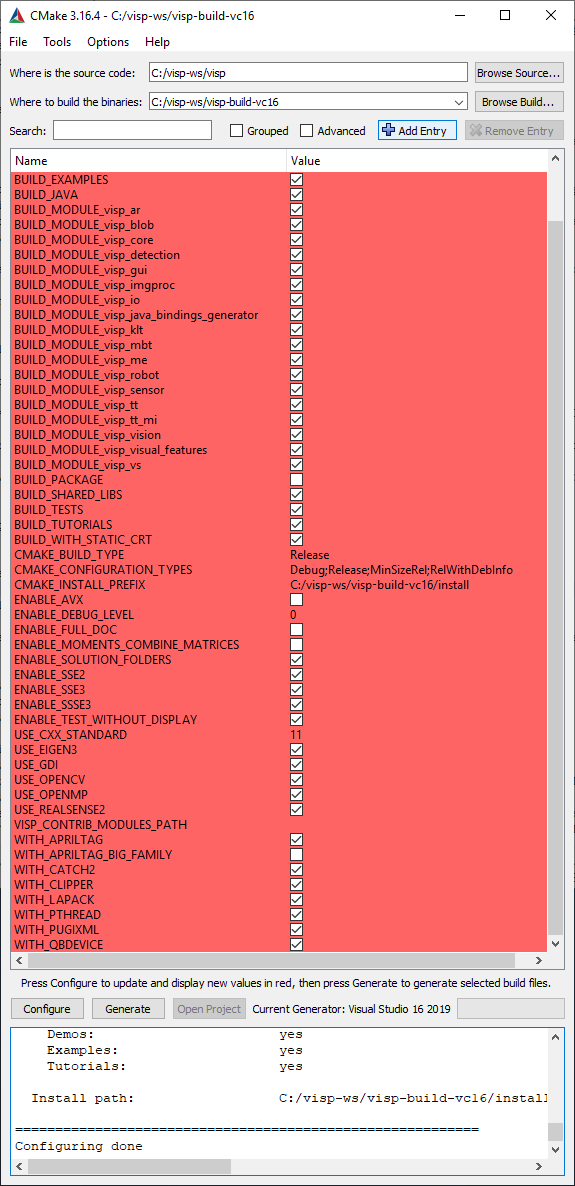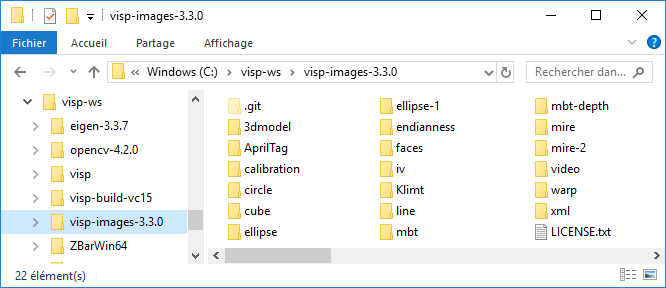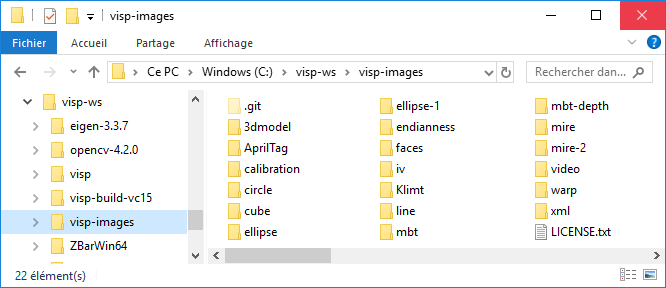 |
Visual Servoing Platform
version 3.3.0 under development (2020-02-17)
|
 |
Visual Servoing Platform
version 3.3.0 under development (2020-02-17)
|
In this tutorial you will learn how to install ViSP from source on Windows 10 with Visual C++. These steps have been tested on Windows 10 (64 bit), with CMake 3.16.4 and Visual Studio Community 2019.
Visual Studio Community 2019 could be downloaded from https://www.visualstudio.com/downloads/. During a fresh installation enable "Desktop development with C++" workload and check box "Windows 10 SDK" to enable usage of the Graphical Device Interface (GDI) useful to display images in a window thanks to vpDisplayGDI class. After a fresh installation, start Visual Studio and create an empty C++ project to install the common tools for Visual C++ 2019.
If you already have Visual Studio Community 2019, you can check if "Desktop Development with C++" workload is activated and if "Windows 10 SDK" is enabled following instructions given here that we resume:

CMake could be download from http://www.cmake.org. Download the latest release for Windows win64-x64 platform (at the time this tutorial was written it was the file cmake-3.16.4-win64-x64.msi). To install just double click on the msi file.
Install Git for Windows from https://git-for-windows.github.io/. This installation allows then to use git in a cmd Command Prompt.
If not already done, create a workspace that will contain all ViSP source, build, data set and optional 3rd parties. This workspace is here set to C:\visp-ws folder, but it could be set to any other location.
To create the workspace, open a cmd Command Prompt (a fast way to launch this window is to press the Win + R keys on your keyboard. Then, type cmd or cmd.exe and press Enter or click/tap OK) and run the following to create a workspace environment var named VISP_WS:
Open a new cmd Command Prompt and create the corresponding folder
In this section, we give minimal instructions to build ViSP from source just to try ViSP without entering in Advanced ViSP installation.
cmd Command Prompt and get ViSP source code in the workspace %VISP_WS%\visp-build-vc16\install folderPath var to add %VISP_WS%\visp-build-vc16\install\x64\vc16\bin corresponding to the path to ViSP libraries. To this end, in a cmd Command Prompt run: setx command is not able to handle a var that has more than 1024 characters (which could be the case of Path var), it may happen that the previous command is not working as expected. In that case, to modify Path environment variable do the following:%VISP_WS%\visp-build-vc16\install\x64\vc16\binVISP_DIR var to help CMake to find ViSP as a 3rd party To have a trial, just jump to Install ViSP data set before running some binaries that you just build or jump to Next tutorial. You can later come back to the Advanced ViSP installation.
ViSP is interfaced with several 3rd party libraries. The complete list is provided here. We recommend to install OpenCV 3rd party in the workspace. If you have an Intel Realsense depth camera you may also install librealsense 3rd party. If your camera is a PointGrey you may install FlyCapture 3rd party, while if your camera is a Basler, you may rather install Pylon 3rd party. To use optimized matrix operations you may install Eigen3 3rd party. Other 3rd parties are optional and should be considered only by expert developers.
1. Get OpenCV
First you have to get OpenCV:
opencv-4.2.0-vc14_vc15.exe Win pack installer. The same procedure could be applied with all the previous OpenCV releases starting from 3.4.0 version.%VISP_WS%. 
%VISP_WS%\opencv.%VISP_WS%\opencv-4.2.0.2. Build OpenCV from source
%VISP_WS%\opencv-4.2.0\build: 2. Complete OpenCV installation
Now you have to complete OpenCV installation setting some environment vars:
OpenCV_DIR environment variable. Start up a cmd Command Prompt and enter: %VISP_WS%\opencv-4.2.0\build is where you have installed OpenCV. Inside this folder you should have a file named OpenCVConfig.cmake.Path environment variable. Open the "Edit environment variable" UI, and modify Path to add a new line with %VISP_WS%\opencv-4.2.0\build\x64\vc16\bin.Even if Eigen3 is designed as a template we recommend to install the library with Visual Studio.
1. Get Eigen3
eigen-eigen-323c052e1731.zip archive corresponding to Eigen 3.3.7.%VISP_WS%.%VISP_WS%\eigen-eigen-323c052e1731 in %VISP_WS%\eigen-3.3.72. Build and install Eigen3 from source
%VISP_WS%\eigen-3.3.7\build-vc16\install folder): %VISP_WS%\eigen-3.3.7\build-vc16\install folder3. Complete Eigen3 installation
Now you have to complete Eigen3 installation setting some environment vars:
EIGEN_DIR environment variable. Start up a cmd Command Prompt and enter: %VISP_WS%\eigen-3.3.7\build-vc16\install is where you have installed Eigen3. Inside the folder %VISP_WS%\eigen-3.3.7\build-vc16\install\share\eigen3\cmake you should have a file named Eigen3Config.cmake.Path environment var since Eigen3 is a template that has no library.I you have an Intel RealSense Depth camera (SR300 or D400 series), you may install librealsense 2.x in order to use vpRealSense2 class. Otherwise you can skip this section.
1. Install Intel Realsense SDK 2.0
Intel Realsense SDK 2.0 contains librealsense. To install this SDK:
Intel.RealSense.SDK-win10.exe corresponding to the last Intel Realsense SDK 2.0 release. At the time this tutorial was written, we downloaded Intel.RealSense.SDK-win10.exe corresponding to build 2.21.0.Intel.RealSense.SDK-win10.exe and follow default installation steps.2. Complete Intel Realsense SDK 2.0 installation
To finalize the installation, add the location of realsense2.dll library in the Path environment variable. Open the "Edit environment variable" UI, and modify Path to add a new line with C:\Program Files (x86)\Intel RealSense SDK 2.0\bin\x64.
I you have a PointGrey or FLIR USB 2.0, USB 3.0, GigE or FireWire camera (DragonFly2, Flea3...), you may install FlyCapture. Otherwise you can skip this section.
Complete installation instructions are given here. We recap hereafter the main instructions to install FlyCapture SDK under Windows:
FlyCapture_2.13.3.61_x64.exe file.If you have a Basler FireWire, Camera Link, GigE or USB3.0 camera, you may install Pylon SDK. Otherwise you can skip this section.
To install Pylon:
Basler_pylon_5.2.0.13457.exe file, but at the time this tutorial was written, we issued an installation error. In that case try to install "Pylon 5.1.0 Camera Software Suite Windows".
C:\Program Files\Basler\pylon 5\ and click on "Next" buttonThere are different ways to get ViSP source code.
visp-x.y.z.tar.gz or visp-x.y.z.zip is downloaded, uncompress the file in %VISP_WS%\visp\visp-x.y.z using for axample WinRAR.%VISP_WS%\visp\visp-x.y.z using for axample WinRAR.git command line tool: We suppose now that ViSP source is in %VISP_WS%\visp.
The goal of the configuration step is now to use CMake to produce a Visual Studio C++ solution file that will be located in %VISP_WS%/visp-build-vc16.


%VISP_WS%/visp-build-vc16 folder.

%VISP_WS%/visp-build-vc16/install. If you want to change the installation folder to C:\Program Files (x86)\ViSP, make sure that you have administrator privileges to write in that folder before modifying CMAKE_INSTALL_PREFIX. Eigen3_DIR environment var, you will get the following warning in cmake_gui: cmake-guiEigen3_DIR environment var running setx Eigen3_DIR "%VISP_WS%\eigen-3.3.7\build-vc16\install\share\eigen3\cmake"cmake-guiFile > Delete Cache
.dll extension). This is the default configuration that is recommended. If you want to create rather a static library (with .lib extension) you have to uncheck the BUILD_SHARED_LIBS option to disable DLL creation.
%VISP_WS%/visp-build-vc16 folder you have the Visual Studio VISP.sln generated solution file.%VISP_WS%/visp-build-vc16/VISP.sln solution file. This action will open ViSP project in Visual Studio C++. By default, Visual Studio opens the solution in Debug configuration. Modify the configuration to "Release". 
"Build > Build Solution" to build ViSP or hit "Ctrl+Shift+B".
"INSTALL" project. To this end, apply a left click on "INSTALL" to select the project, then a right click to enter in the "Build" menu. 

%VISP_WS\visp-build-vc16\install folder; headers and libraries in include and x64/vc16 subfolders respectively."Release" configuration. Now in %VISP_WS%/visp-build-vc16/install/x64/vc16/bin folder you have ViSP DLL libraries corresponding to ViSP modules. 
Debug configuration. In that case, all the library names are suffixed by "d" character (libvisp_core320d.dll...).To build ViSP documentation, you have first to install Doxygen:
doxygen-1.8.16-setup.execmd Command Prompt and enter build directory The generated documentation is then available in $VISP_WS/visp-build-vc16/doc/html/index.html
ENABLE_FULL_DOC to ON like: Modify the Path var to add the path to ViSP dll libraries. To this end open the "Edit environment variable" UI, and modify Path to add a new line with %VISP_WS%\visp-build-vc16\install\x64\vc16\bin.
Modifying the Path could also be done in a cmd Command Prompt running:
In order to ease ViSP detection by CMake when ViSP is used as a 3rd party in an external project, like the one described in the Tutorial: How to create and build a CMake project that uses ViSP on Unix or Windows, you may set VISP_DIR environment variable with the path to the VISPConfig.cmake file:
Some ViSP examples and tests require a data set that contains images, video, models that is not part of ViSP source code. This data set is available in Github (https://github.com/lagadic/visp-images) or as a release in a separate archive named visp-images-x.y.z.zip. This archive could be downloaded from http://visp.inria.fr/download page. Note that ViSP tutorials are not using ViSP data set.
We give hereafter the two ways to get this data set:
1. Get data set release
visp-images-3.3.0.zip from https://visp.inria.fr/download and uncompress it in your workspace %VISP_WS%. 
VISP_INPUT_IMAGE_PATH environment variable to help ViSP examples and tests to detect automatically the location of the requested data. In our case, this variable should be set to %VISP_WS%\visp-images-3.3.0. Open a cmd Command Prompt and run 2. Get data set from github

VISP_INPUT_IMAGE_PATH environment variable to help ViSP examples and tests to detect automatically the location of the requested data. In our case, this variable should be set to %VISP_WS%\visp-images. Open a cmd Command Prompt and run Test data set usage
From now, you can try to run ViSP examples and tests. For example, if you want to run %VISP_WS%\visp-build-vc15\example\device\display\Release\displayGDI.exe, open a cmd Command Prompt, enter in the right folder and run:
Since all 3rd parties are optional you may have started to install only some of them. Imagine that you just installed a new third-party, or that you upgraded the version of this 3rd party. The next step is to go back to the build folder, configure ViSP with CMake to detect the newly installed third-party library and build again ViSP. This could be achieved with:
Here you can check the content of the ViSP-third-party.txt file and see if the newly installed 3rd party is well detected.
Finally, you need to rebuild and install ViSP with:
After ViSP installation, you can remove installed material using:
If you want to build only ViSP modules libraries, nor the examples, tutorials and tests:
If you want to build a given module and all the dependencies:
For example to build the model-based tracker module named mbt, run:
To see which are the optional 3rd parties that are found during the configuration stage and that will be used by ViSP during the build you can have a look to the text file named ViSP-third-party.txt and located in $VISP_WS/visp-build. We provide hereafter an example of a possible content of this file that contains also build info.
You are now ready to see the next Tutorial: How to create and build a CMake project that uses ViSP on Unix or Windows that will show you how to use ViSP as a 3rd party to build your own project.